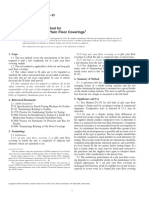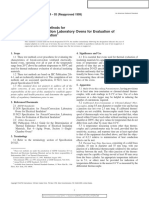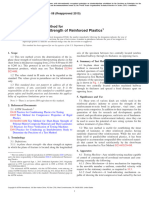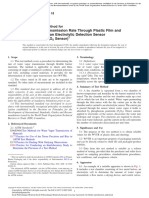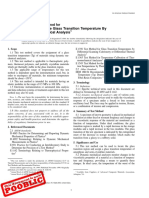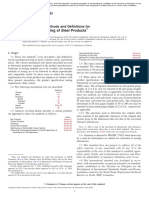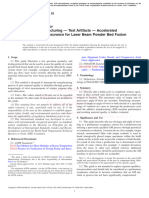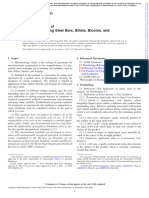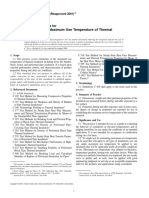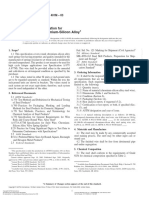Astm 472 PDF
Astm 472 PDF
Uploaded by
JOSEPH REFUERZOCopyright:
Available Formats
Astm 472 PDF
Astm 472 PDF
Uploaded by
JOSEPH REFUERZOOriginal Title
Copyright
Available Formats
Share this document
Did you find this document useful?
Is this content inappropriate?
Copyright:
Available Formats
Astm 472 PDF
Astm 472 PDF
Uploaded by
JOSEPH REFUERZOCopyright:
Available Formats
Designation: A 472/A 472M – 05
Standard Test Method for
Heat Stability of Steam Turbine Shafts and Rotor Forgings1
This standard is issued under the fixed designation A 472/A 472M; the number immediately following the designation indicates the year
of original adoption or, in the case of revision, the year of last revision. A number in parentheses indicates the year of last reapproval.
A superscript epsilon (e) indicates an editorial change since the last revision or reapproval.
1. Scope* centered and machined with allowance to finish to the purchas-
1.1 This test method covers the determination of heat er’s drawing. Material for mechanical tests may be removed
stability of steam turbine shafts and rotor forgings to ensure before or after the stability test at the manufacturer’s option,
stability at operating temperature. This test method is not unless check tests after the stability test are required by the
ordinarily applicable to generator rotor forgings. purchaser.
1.2 This test method is expressed in both inch-pound unit 3.2 With prior approval from the purchaser, the forgings
and in SI units; however, unless the purchase order or contract may be stress-relieved as part of the heat stability test. When
specifies the applicable M specification designation (SI units), this is done, the stress-relieving temperature shall be within 50
the inch-pound units shall apply. The values stated in either to 100°F [30 to 55°C] below final tempering temperature.
inch-pound units or SI units are to be regarded separately as Rotate the forgings at 2 to 4 r/min and hold at stress-relieving
standard. Within the test method, the SI units as shown in temperature for at least 2 h/in. [2 h/25 mm] of maximum radial
brackets. The values stated in each system may not be exact thickness, after which the temperature may be decreased to the
equivalents; therefore, each system shall be used independently specified heat stability test temperature and the test performed.
of the other. Combining values from the two systems may 4. Heat Stability Test Bands
result in nonconformance with the standard.
1.3 Supplementary requirements of an optional nature are 4.1 The supplier shall mark positions A, B, C, and D, spaced
provided for use at the option of the purchaser. The supple- 90° apart circumferentially, preferably on an end of the forging.
mentary requirements shall apply only when specified indi- Markings shall be retained throughout all subsequent opera-
vidually by the purchaser in the purchase order or contract. tions.
1.4 This standard does not purport to address all of the 4.2 Preferably, there shall be a minimum of 5 test bands,
safety concerns, if any, associated with its use. It is the denoted as 1, 2, 3, 4, and 5, machined on the circumference of
responsibility of the user of this standard to establish appro- the forging. Numbering shall start at the left side of the forging
priate safety and health practices and determine the applica- drawing. Bands 1 and 5 shall be located as close to the end of
bility of regulatory limitations prior to use. the forging as practical. Band 3 shall be located as near to
midlength as practical. Bands 2 and 4 shall be located
2. Ordering Information approximately equidistant between 1 and 3, and 3 and 5,
2.1 It shall be the responsibility of the purchaser to specify respectively.
all requirements necessary for testing under this specification. 4.3 When the shipped length of the barrel portion of the
Requirements to be considered include, but are not limited to, forging is less than 8 ft [2.4 m], bands 2 and 4 may be omitted.
the following: 4.4 The purchaser’s drawing may show the desired number
2.1.1 ASTM designation and year date, and location of bands and shall indicate that portion of the
2.1.2 The minimum test temperature, forging that shall be located within the heating chamber. Bands
2.1.3 The portion of the forging to be subjected to the heat 1 and 5 are to be located outside of the heating chamber.
stability test temperature, and Preferably, the gland areas/packing seal areas are inside the
2.1.4 Supplementary or other special requirements. heating chamber.
4.5 The test bands shall be machined with the forging
3. Procedure running on centers except in the cases of forgings weighing
3.1 The heat stability test shall be conducted by the forging over 125 000 lb [56.7 metric tons] the machining shall be
supplier after final heat treatment and after the forging has been performed with the forgings running on steady rests. Readings
shall be taken with the forging running on centers except in the
cases of forgings weighing over 125 000 lb [56.7 metric tons]
1
This test method is under the jurisdiction of ASTM Committee A01 on Steel, where readings may be taken with the forgings running on
--```,,`,`,``````,``,`,`,`,,``,-`-`,,`,,`,`,,`---
Stainless Steel, and Related Alloys and is the direct responsibility of Subcommittee
A01.06 on Steel Forgings and Billets.
steady rests. Between readings, the forgings may be rotated on
Current edition approved Sept. 1, 2005. Published September 2005. Originally steady rests.
approved in 1962. Last previous edition approved in 2003 as A 472 – 98 (2003).
*A Summary of Changes section appears at the end of this standard.
Copyright © ASTM International, 100 Barr Harbor Drive, PO Box C700, West Conshohocken, PA 19428-2959, United States.
Copyright ASTM International 1
Copyright by ASTM Int'l (all rights reserved);
Provided by IHS under license with ASTM Licensee=Bechtel Corp Loc 1-19/9999056100, User=Ibanez, Efren
No reproduction or networking permitted without license from IHS Not for Resale, 10/17/2006 20:30:04 MDT
Reproduction authorized per License Agreement with Kathe Hooper (ASTMIHS Account); Mon Sep 26 13:18:46 EDT 2005
A 472/A 472M – 05
5. Surface Preparation exceed 0.002 in. [0.05 mm] in any band. Refer to the last
5.1 Remove oil, grease, dirt, and other foreign material from measurements as the official first cold measurements.
the surface of the forging prior to the heat stability test. A 7.3 Hot Measurements—Take measurements on all bands
suitable coating may be applied to provide uniform emissivity. hourly during the heating cycle until the forging has been
heated to the specified temperature. When three consecutive
6. Heating and Cooling hourly deflection measurements at the specified temperature
6.1 Place the forging in the heating chamber and rotate the check within 0.0005 in. [0.013 mm], cooling may commence.
forging at a speed of 2 to 4 r/min. Refer to the last of these measurements as the official hot
6.2 Place thermocouples in contact with the forging at each measurements.
test band within the heating chamber. Shield the thermocouples 7.4 Second Cold Measurements—After cooling in accor-
from the heat source. dance with 6.4, take measurements on all bands at half-hour
6.3 Apply heat uniformly to avoid localized overheating. intervals until two consecutive deflection measurements check
Heat the forging at a rate not exceeding 200°F/h [110°C/h] to within 0.0005 in. [0.013 mm]. Refer to the last of these
the stability test temperature specified by the purchaser. Main- measurements as the official second cold measurements.
tain the specified testing temperature until the forging is heated
uniformly. A uniform temperature condition shall be consid- 8. Interpretation of Results
ered to exist when three consecutive hourly deflection mea- 8.1 The forging shall be acceptable if the movement of its
surements taken at the test temperature are within 0.0005 in. center is not greater than 0.001 in. [0.025 mm] when deter-
[0.013 mm]. To consider a uniform test temperature condition mined by the difference between the official hot and the official
to exist, it is also necessary that the axial thermal expansion be cold second measurements. This movement shall be deter-
consistent within 0.010 in. [0.25 mm] for three consecutive mined for each band as follows:
hourly readings at the test temperature. 8.1.1 From the official hot measurements at position A
6.4 After uniform test conditions as described in 6.3 have subtract the official cold measurement for position A.
been reached, cool the forging, while rotating, to below 100°F 8.1.2 Repeat the procedure for positions B, C, and D.
[40°C]. The heating chamber may be opened during cooling, 8.1.3 For each of these four results, numerically total the
but the cover shall not be removed until the temperature of the greatest plus value and the greatest minus value without regard
forging is less than 500°F [260°C]. After the forging has cooled to sign. The maximum deflection in any band as indicated by
to approximately room temperature, rotate it for at least 2 h these totals shall not exceed 0.002 in. [0.05 mm].
before the second cold measurements (see 7.4) are recorded. 8.2 In case of changes in measurements in bands 1 and 5,
suitable corrections may be made to results obtained from
7. Stability Measurements bands 2, 3, and 4. The corrected figures shall be within the
7.1 Use an indicator located outside the heating chamber to requirements of 8.1.3.
measure to the nearest 0.0005 in. [0.013 mm]. Actuate the 8.3 If the forging does not meet the requirements of the
indicator by a rod with one end contacting the forging at test stability test, it may be retested, stress relieved before retest or
bands described in 4.2 or 4.3. Take measurements at each test completely reheat treated before retest.
band at positions A, B, C, and D. For each band, the indicator
may be set to zero for the minimum deflection at one of the 9. Report
positions A, B, C, or D or the figures may be reduced to 9.1 The forging supplier shall report to the purchaser the
minima by subtraction. official first cold measurements, the hourly measurements
7.2 First Cold Measurements—Take measurements on each during heating and holding at specified temperature, the official
band after rotation is started but prior to heating. If the runout hot measurements and the official second cold measurements,
exceeds 0.002 in. [0.05 mm] at any band, continue rotation for as well as the temperature of the forging when these measure-
1 h. If runout continues to exceed 0.002 in. [0.05 mm], recenter ments were obtained. The report shall include the calculated
the forging or remachine the bands until the runout does not change in measurements as determined under 8.1.3.
--```,,`,`,``````,``,`,`,`,,``,-`-`,,`,,`,`,,`---
Copyright ASTM International 2
Copyright by ASTM Int'l (all rights reserved);
Provided by IHS under license with ASTM Licensee=Bechtel Corp Loc 1-19/9999056100, User=Ibanez, Efren
No reproduction or networking permitted without license from IHS Not for Resale, 10/17/2006 20:30:04 MDT
Reproduction authorized per License Agreement with Kathe Hooper (ASTMIHS Account); Mon Sep 26 13:18:46 EDT 2005
A 472/A 472M – 05
SUPPLEMENTARY REQUIREMENTS
The following supplementary requirements shall only apply when specified individually by the
purchaser in the contract or purchase order.
S1. Emissivity Coating uniform and completely cover all surfaces within and adjacent
S1.1 Apply a surface coating that will provide a uniform to the ovens. Successive light coats applied by spraying are
thermal emissivity throughout the test. The coating shall be recommended.
SUMMARY OF CHANGES
Committee A01 has identified the location of selected changes to this specification since the last issue
(A 472 – 98 (2003)), which may impact its use.
(1) Added Supplementary Requirement S1. (2) Converted Test Method to Dual Units.
ASTM International takes no position respecting the validity of any patent rights asserted in connection with any item mentioned
--```,,`,`,``````,``,`,`,`,,``,-`-`,,`,,`,`,,`---
in this standard. Users of this standard are expressly advised that determination of the validity of any such patent rights, and the risk
of infringement of such rights, are entirely their own responsibility.
This standard is subject to revision at any time by the responsible technical committee and must be reviewed every five years and
if not revised, either reapproved or withdrawn. Your comments are invited either for revision of this standard or for additional standards
and should be addressed to ASTM International Headquarters. Your comments will receive careful consideration at a meeting of the
responsible technical committee, which you may attend. If you feel that your comments have not received a fair hearing you should
make your views known to the ASTM Committee on Standards, at the address shown below.
This standard is copyrighted by ASTM International, 100 Barr Harbor Drive, PO Box C700, West Conshohocken, PA 19428-2959,
United States. Individual reprints (single or multiple copies) of this standard may be obtained by contacting ASTM at the above
address or at 610-832-9585 (phone), 610-832-9555 (fax), or service@astm.org (e-mail); or through the ASTM website
(www.astm.org).
Copyright ASTM International 3
Copyright by ASTM Int'l (all rights reserved);
Provided by IHS under license with ASTM Licensee=Bechtel Corp Loc 1-19/9999056100, User=Ibanez, Efren
No reproduction or networking permitted without license from IHS Not for Resale, 10/17/2006 20:30:04 MDT
Reproduction authorized per License Agreement with Kathe Hooper (ASTMIHS Account); Mon Sep 26 13:18:46 EDT 2005
You might also like
- Astm F2170Document7 pagesAstm F2170AhmedNo ratings yet
- Astm E340 23Document6 pagesAstm E340 23ARINDAM SETT100% (1)
- E 399Document31 pagesE 399H_DEBIANENo ratings yet
- A941-13b Standard Terminology Relating To Steel, Stainless Steel, Related Alloys, and FerroalloysDocument8 pagesA941-13b Standard Terminology Relating To Steel, Stainless Steel, Related Alloys, and FerroalloysChuthaNo ratings yet
- Astm D 1335 - 03Document4 pagesAstm D 1335 - 03Liu SilverNo ratings yet
- Astm D 5374Document3 pagesAstm D 5374Veronica MolinaNo ratings yet
- Ideal Regenerative Cycle - Practice Problem No.3 Solutions PDFDocument9 pagesIdeal Regenerative Cycle - Practice Problem No.3 Solutions PDFJOSEPH REFUERZO0% (1)
- Astem E-290Document12 pagesAstem E-290Ricardo Peralta100% (1)
- Fiberglass Reinforced Styrene-Butadiene-Styrene (SBS) Modified Bituminous Sheets With A Factory Applied Metal SurfaceDocument3 pagesFiberglass Reinforced Styrene-Butadiene-Styrene (SBS) Modified Bituminous Sheets With A Factory Applied Metal SurfaceKevin Josue100% (1)
- Apparent Hoop Tensile Strength of Plastic or Reinforced Plastic PipeDocument11 pagesApparent Hoop Tensile Strength of Plastic or Reinforced Plastic PipeedonfindsNo ratings yet
- (Eng) ASTM D3846-08 Standard Test Method For In-Plane Shear Strength of Reinforced PlasticsDocument3 pages(Eng) ASTM D3846-08 Standard Test Method For In-Plane Shear Strength of Reinforced Plasticsjaehoon.ahnNo ratings yet
- Astm D1005-1995 Rev 2020Document3 pagesAstm D1005-1995 Rev 2020jose reyNo ratings yet
- Measurement of Rate of Absorption of Water by Hydraulic-Cement ConcretesDocument6 pagesMeasurement of Rate of Absorption of Water by Hydraulic-Cement Concreteseduardo bonillaNo ratings yet
- Design and Construction of Welded Wire Fence Systems For Security PurposesDocument4 pagesDesign and Construction of Welded Wire Fence Systems For Security PurposesGabriel Perez CruzNo ratings yet
- Evaluating The Microstructure of Graphite in Iron Castings: Standard Test Method ForDocument13 pagesEvaluating The Microstructure of Graphite in Iron Castings: Standard Test Method ForHERNAN DARIO INCHIMA CALDERONNo ratings yet
- Astm G32Document16 pagesAstm G32GilmarBosNo ratings yet
- Astm F3299.23586Document4 pagesAstm F3299.23586Zohreh MosaferiNo ratings yet
- ISO 16163 - (2012) - (Continuos HDG-Dimensional and Shape-Tolerances) - 10pgsDocument10 pagesISO 16163 - (2012) - (Continuos HDG-Dimensional and Shape-Tolerances) - 10pgsdpfloresNo ratings yet
- Astm c1090Document5 pagesAstm c1090ivanhermalNo ratings yet
- B645 20547 PDFDocument6 pagesB645 20547 PDFunknown1711No ratings yet
- Astm E1640 - 1 (En)Document5 pagesAstm E1640 - 1 (En)Sainath AmudaNo ratings yet
- Astm-D1709-22. Impacto Al DardoDocument5 pagesAstm-D1709-22. Impacto Al Dardofibratest.asistenteNo ratings yet
- F659-10 Standard Specification For Ski and Snowboard GogglesDocument8 pagesF659-10 Standard Specification For Ski and Snowboard GogglesAhmed Rekaby100% (2)
- D648 14513Document14 pagesD648 14513Ana Laura LopesNo ratings yet
- Preparation of Cold-Rolled Steel Panels For Testing Paint, Varnish, Conversion Coatings, and Related Coating ProductsDocument3 pagesPreparation of Cold-Rolled Steel Panels For Testing Paint, Varnish, Conversion Coatings, and Related Coating ProductsjamNo ratings yet
- Astm C109Document6 pagesAstm C109nicol pomaNo ratings yet
- D3575-14 Standard Test Methods For Flexible Cellular Materials Made From Olefin PolymersDocument11 pagesD3575-14 Standard Test Methods For Flexible Cellular Materials Made From Olefin Polymersisadora ruasNo ratings yet
- Astm C518 21Document7 pagesAstm C518 21sbiplcc27No ratings yet
- Astm A47 A47m (1999)Document5 pagesAstm A47 A47m (1999)Narendrasinh JadejaNo ratings yet
- Astm B487Document2 pagesAstm B487אלון ספיריהNo ratings yet
- Is 12308-4 - 1988 - 2Document1 pageIs 12308-4 - 1988 - 2Svapnesh ParikhNo ratings yet
- Iso 2286 2 2016Document9 pagesIso 2286 2 2016Rohit SinghNo ratings yet
- Astm C-1384Document5 pagesAstm C-1384yayan febriantoNo ratings yet
- Tension Testing Wrought and Cast Aluminum-And Magnesium-Alloy ProductsDocument16 pagesTension Testing Wrought and Cast Aluminum-And Magnesium-Alloy ProductsEhab HarbNo ratings yet
- Astm C 1166Document3 pagesAstm C 1166Mehmet Gökhan YüzgeçNo ratings yet
- En Iso 1183-3Document12 pagesEn Iso 1183-3aeotomasyonNo ratings yet
- Mechanical Hydrogen Embrittlement Evaluation of Plating/ Coating Processes and Service EnvironmentsDocument19 pagesMechanical Hydrogen Embrittlement Evaluation of Plating/ Coating Processes and Service EnvironmentsLeo Costa100% (1)
- C156 PDFDocument5 pagesC156 PDFMateriales FicNo ratings yet
- ASTM C490-17 Standard Practice For Use of Apparatus For The Determination of Length Change of Hardened Cement Paste, Mortar, and ConcreteDocument5 pagesASTM C490-17 Standard Practice For Use of Apparatus For The Determination of Length Change of Hardened Cement Paste, Mortar, and ConcreteKartika Setia RiniNo ratings yet
- Mechanical Testing of Steel Products: Standard Test Methods and Definitions ForDocument51 pagesMechanical Testing of Steel Products: Standard Test Methods and Definitions ForМзевинар КобахидзеNo ratings yet
- AstmDocument6 pagesAstmrenefbgNo ratings yet
- ASTM C 39 Standard Test Method For Compressive Strength of Cylindrical Concrete SpecimensDocument8 pagesASTM C 39 Standard Test Method For Compressive Strength of Cylindrical Concrete SpecimensMohamed HunaisNo ratings yet
- ASTM-C1314-07 (2007) - Compressive Strength of Masonry PrismsDocument10 pagesASTM-C1314-07 (2007) - Compressive Strength of Masonry PrismsMohammad Raihan MukhlisNo ratings yet
- ASTM D5147 - Sampling and Testing Modified Bituminous Sheet Material1Document5 pagesASTM D5147 - Sampling and Testing Modified Bituminous Sheet Material1jothi vel muruganNo ratings yet
- Astm E2818-11 PDFDocument4 pagesAstm E2818-11 PDFJhonatan CalloapazaNo ratings yet
- A242 A242M (2001) Standard Specification For High-Strength Low-Alloy Structural SteelDocument3 pagesA242 A242M (2001) Standard Specification For High-Strength Low-Alloy Structural SteelGagan Singh100% (1)
- Astm A1078 A1078m 22Document3 pagesAstm A1078 A1078m 22nauris.ezerlicisNo ratings yet
- Astm D1785 (2012) PDFDocument11 pagesAstm D1785 (2012) PDFchairul anwarNo ratings yet
- Astm D 3542Document4 pagesAstm D 3542manoj madurangaNo ratings yet
- Standard Specification For Woven Wire Test Sieve Cloth and Test SievesDocument12 pagesStandard Specification For Woven Wire Test Sieve Cloth and Test SievesviverefeliceNo ratings yet
- Astm C868-02 PDFDocument4 pagesAstm C868-02 PDFIan HsuNo ratings yet
- Astm F3626 23Document3 pagesAstm F3626 23Reginald ElvisNo ratings yet
- Astm A1063A1063MDocument11 pagesAstm A1063A1063Mارفع راسك فوق انت يمنيNo ratings yet
- PDF Astm c171 - CompressDocument2 pagesPDF Astm c171 - CompressNala BlackfireNo ratings yet
- G204 - 2751 FrettingDocument6 pagesG204 - 2751 Frettingdeepdreamx6400No ratings yet
- Astm E381-20Document5 pagesAstm E381-20Александр Л100% (1)
- A472A472M-07 (2012) Standard Specification For Heat Stability of Steam Turbine Shafts and Rotor ForgingsDocument3 pagesA472A472M-07 (2012) Standard Specification For Heat Stability of Steam Turbine Shafts and Rotor ForgingssasithNo ratings yet
- Standard Specification For Heat Stability of Steam Turbine ShaftsDocument3 pagesStandard Specification For Heat Stability of Steam Turbine ShaftsMboriko MwashaNo ratings yet
- Forced-Convection Laboratory Ovens For Evaluation of Electrical InsulationDocument3 pagesForced-Convection Laboratory Ovens For Evaluation of Electrical InsulationMa PonyNo ratings yet
- Diseño Geométrico de CarreterasDocument3 pagesDiseño Geométrico de CarreterasBruno Ramírez PonceNo ratings yet
- C 447 - 03 QZQ0NWDocument3 pagesC 447 - 03 QZQ0NWM RNo ratings yet
- Astm 437 PDFDocument3 pagesAstm 437 PDFJOSEPH REFUERZONo ratings yet
- Astm 531Document5 pagesAstm 531JOSEPH REFUERZONo ratings yet
- COMPOSITES FinalDocument29 pagesCOMPOSITES FinalJOSEPH REFUERZONo ratings yet
- Metals: Dato, Dominic M. Esquillo, Mark Ryan L. Fabia, Bernardo M. Sison, Elijah G. Tan, Nicolas TDocument30 pagesMetals: Dato, Dominic M. Esquillo, Mark Ryan L. Fabia, Bernardo M. Sison, Elijah G. Tan, Nicolas TJOSEPH REFUERZONo ratings yet
- Astm 471Document6 pagesAstm 471JOSEPH REFUERZONo ratings yet
- Corrosion: Mechanical Engineering Department ME 006 - ME41FB1Document20 pagesCorrosion: Mechanical Engineering Department ME 006 - ME41FB1JOSEPH REFUERZONo ratings yet
- Conveyor TechnologyDocument13 pagesConveyor TechnologyJOSEPH REFUERZONo ratings yet
- Nano Materials: de Leon, Norwin Leynard C. Refuerzo, Joseph FDocument26 pagesNano Materials: de Leon, Norwin Leynard C. Refuerzo, Joseph FJOSEPH REFUERZONo ratings yet
- Multimachine Final Na Talaga PDFDocument105 pagesMultimachine Final Na Talaga PDFJOSEPH REFUERZONo ratings yet
- Machine Design II: Engr. Zhierwinjay M. Bautista Name of FacultyDocument11 pagesMachine Design II: Engr. Zhierwinjay M. Bautista Name of FacultyJOSEPH REFUERZONo ratings yet
- Polymers: - Me YouthDocument37 pagesPolymers: - Me YouthJOSEPH REFUERZONo ratings yet
- Conveyors HistoryDocument17 pagesConveyors HistoryJOSEPH REFUERZO100% (1)
- Hydraulic and Robotic ArmsDocument32 pagesHydraulic and Robotic ArmsJOSEPH REFUERZONo ratings yet
- Industrial Processes PDFDocument58 pagesIndustrial Processes PDFJOSEPH REFUERZONo ratings yet
- Astm 401 PDFDocument4 pagesAstm 401 PDFJOSEPH REFUERZONo ratings yet
- Fan TypesDocument16 pagesFan TypesJOSEPH REFUERZONo ratings yet
- Astm 494Document7 pagesAstm 494JOSEPH REFUERZO100% (1)
- Astm 487Document6 pagesAstm 487JOSEPH REFUERZO100% (1)
- Ideal Regenerative Cycle PDFDocument9 pagesIdeal Regenerative Cycle PDFJOSEPH REFUERZONo ratings yet




